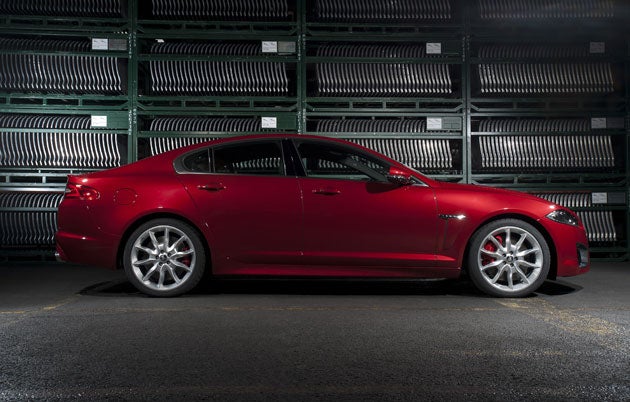Jaguar XF SE 2.2-litre diesel

Top speed: 142 mph
Acceleration: 0-62 mph in 8.5 seconds
Fuel consumption: 52.3 mpg
CO2 emissions: 149 g/km
Price: 30,950 Jaguar's XF SE represents one of the motor industry's most predictable mid-life updates ever – but it is no less welcome or impressive for that.
When I first reviewed a diesel-engined XF back in 2008 – the original version had a 2.7-litre V6 - like just about everybody else who tried it, I was very impressed. I did, though, enter the following caveat: “...while the XF is an outstanding product, I suspect that, once the excitement that greeted its introduction has died down, it may not be quite enough. At the moment, the XF range starts at a lofty £33,900 and offers no equivalent to the entry-level, low-CO2 emitting BMW 520d and Mercedes E220 CDI, its obvious company-car competitors. That probably needs to be fixed within a year if Jaguar is to maintain the momentum it has achieved since launching the XF. An estate model is essential too, if only as a means of hanging on to customers deserting the 4x4s made by Jaguar's sister company, Land Rover.”
Jaguar did up come with a new diesel engine within about a year, but at 3.0 litres, it was actually bigger, rather than smaller, than the first one - although to the company's credit, despite a useful boost in performance, it was more economical than the 2.7. There's still no sign of that XF estate, either, but Jaguar's progress doesn't seem to have been affected too badly as a result - and a couple of bad winters have done wonders, from Land Rover's point of view, in terms of getting rid of the anti-SUV mood that was gathering pace as we entered the recession.
Now though, Jaguar has finally come up with that smaller diesel to take on BMW's and Mercedes' big-sellers, a development that is bound to boost the company's chances, especially with taxation-conscious company car user-choosers. Was it worth the wait? Customers won't get their hands on the XF SE until later in the year, but I recently had a chance to drive a pre-production model - on the basis of my short drive, the answer appears to be “yes”.
The engine itself is a 2.2 litre four-cylinder turbocharged unit, which provides 190 horsepower (PS) and 450 Newton metres. That's easily enough on paper to provide the sort of performance any buyer would expect from a Jaguar – the company claims a top speed of 142 mph and acceleration from rest to 62 mph of 8.5 seconds. At the same time, the smaller engine holds out the promise of better economy and fuel consumption than XFs have so far been able to deliver. According to official tests, the 2.2-litre diesel XF achieves 52.3mpg on the combined cycle and emits 149g of CO2 per kilometre.
But for a Jaguar, performance is about more than the raw data. A Jag has to feel like a Jag, and the XF SE does - that's quite an achievement given that a four-cylinder engine will never feel quite as smooth or sound quite as interesting as the sixes fitted to more expensive models. The engine is very muted, quite an achievement, given that the company has reduced noise from most other sources to an exceptional degree; when it can be heard, it has an agreeably growly note. One vital ingredient in the new Jag's appeal is its eight-speed automatic gearbox from German transmission suppliers ZF. ZF eight-speeders have already been seen in several cars, including this model's most obvious direct competitor, the BMW 520d, as well as the latest version of the Range Rover from Jaguar's sister company, Land Rover. It's just as good in the XF 2.2 diesel as it is in those other cars; smooth, responsive and always in the right gear. Another interesting piece of technology is this car's stop-start system; probably one of the cleverest seen so far, it provides beautifully unobtrusive restarts and is able to deal with events that might confuse a less sophisticated system such as the so-called “change of mind” scenario where a driver who is slowing to a stop decides to accelerate again before the car comes to a complete rest.
The new Jag's performance is almost identical to that of its two main rivals, the BMW 520d and the Mercedes E 220 CDI, although the two German cars are also available with manual transmission, which delivers a slight edge in CO2 emissions and allows a slightly lower entry price; the Mercedes E-Class is also available in cheaper, less powerful form as the E 200 CDI. On the other hand, the Jag cuts a bit more of a dash than its admittedly excellent rivals, not least because it still has comparative rarity on its side.
The 2.2-litre diesel is part of a modified 2012 XF line-up which also includes a upgrades such as an eight-speed gearbox for the 3.0-litre diesels, and a comprehensive facelift. When I drove the XF recently, it carried a disguise that concealed the restyling which was finally revealed to the world at last week's New York International Motor Show. A new nose, with narrower meaner headlamps strengthens the XF's family resemblance to the larger XJ. At £30,950, this Jag should find plenty of takers.
Subscribe to Independent Premium to bookmark this article
Want to bookmark your favourite articles and stories to read or reference later? Start your Independent Premium subscription today.

Join our commenting forum
Join thought-provoking conversations, follow other Independent readers and see their replies